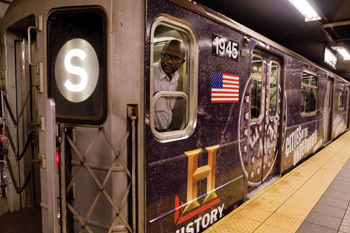Demand a Read/Write City
Via The Anti-Advertising Agency by Steve Lambert
This is graffiti:
- it’s spray paint
- it’s done without permission on someone else’s property
- it’s illegal
- politicians hate it
It’s the expression of a citizen (or small group of citizens) in public space speaking to fellow citizens. Anyone, willing to take the legal risk, can do it.
This is advertising:
- it’s printed vinyl
- it’s done with permission from the city
- it’s legal (When it’s not legal there’s often little to no consequence.)
- legal or not, it makes money - though often not enough
- politicians love it
It’s the expression of a corporate interest. A small number of people who have thousands of dollars, a specific and narrow interest and some influence can do it. They speak to people as consumers, not citizens.
For the first time, the MTA is turning the outside of their trains over to advertising company, Titan Outdoor. It will start with the Times Square shuttle in a test program. But with the potential for more (my emphasis added):
If this test at Grand Central/Times Square stations is successful, other high-traffic stations could easily be included for similar sales packages.
In addition to the above efforts in the GCT/Times Square Area, in the first quarter of 2009 Times Square Shuttle tunnel will also become the home of the first in-tunnel advertising installation. The shuttle riders will be able to view a full motion video presentation through the window of the shuttle car. The MTA is also planning to pilot test a digital dominated station concept at two of the NYCT stations, Grand Central Shuttle Station and 42nd and 6th Avenue Station mezzanine (Bryant Park).
To further expand the advertising revenue base, MTA in partnership with Titan Outdoor (its MTA bus and commuter rail advertising contractor), will be pilot testing digital advertising on one of its NYCT buses and, if successful, hope to expand the program to approximately 200 buses. In addition, a similar digital advertising pilot test is planned for in car commuter rail displays in the near future.
One thing I’m sure of - this install will be amazing. This will likely be bold, and inventive and incorporate amazing new technologies. It will be novel and smart, maybe funny. People will be impressed, if not wowed. And why wouldn’t they be? There will be some of the most creative people in the world working on it with years of research and experience and millions of dollars behind it.
So what’s wrong with this?
First, as usual, it’s not a worthwhile deal for the city. With an annual budget of 11.5 billion, the MTA hopes to bring in another 20 million in ad revenue with the program during the next year - a whopping total of .17% of their budget.
The MTA and New York City are becoming outdoor advertising companies themselves, turning over the captive eyes of commuters for a handful of revenue. Many don’t realize this conflict of interest is making it difficult for the city to regulate advertising, even when it’s clearly illegal.
Another point is that it creates a “read-only” culture. If you’re not familiar with the concept, Lawrence Lessig talks about “read only culture” versus “read/write culture.” He uses this analogy to talk about copyright, but I’m going to radically extend his argument to the city.
Our city is read-only. You’re free to read advertising, business signs, and city signs. But dare you write or hang anything of your own; you will be labeled as a criminal - a graffiti vandal. In many cities it’s even illegal to hang a sign for a garage sale on a light pole. If you happen to have a several thousand dollars, you might be able to say what you want - as long as it’s not too political.
But this is public space. You’re free to say whatever you want in public space, but freedom of speech does not extend to the visual environment. The visual environment is pay to play. Public visual space has become commercial space.
The visual environment is read only.
Why is read/write better? Because you can consume, process, and respond. This is how we think critically. This is how we learn. You can talk back. You can express yourself. You don’t just consume expression, you create expression.
Read/write is how democracy works.
There’s a reason kids want to write their names on walls. There’s a reason why people take graffiti seriously. Granted, graffiti writers don’t always know how to direct this energy, but I’d argue there’s some overlap with the reasons one writes their name on a wall and the reasons one runs for the school board. Being able to write means being able to affect your environment. To change it. You exist in the world not as a consumer, but an active citizen.
Read only culture creates apathy.
So how could the MTA do it right? Strip all the advertising from the transit system. Demand more tax revenue for public transit. Don’t worry, there’s plenty of brilliant ways that to raise money that will also make the city more livable, like increasing parking meter rates to raise $5 billion dollars. Use the surplus money to fund better, more dynamic, and temporary art in transit programs. Create an open application process and let some of New York’s great artists and designers wrap a car. They’ll liven up the system and speak to riders as fellow citizens.
Yes it sounds impossible, but as the Situationists said, “Be realistic, demand the impossible!“
To give more credit, beyond Larry Lessig, I’m also synthesizing some ideas from artist Brett Cook-Dizney and others I can’t think of right away.
Labels: AAA, activism, CBS, criticism, digital advertising, New York, public advertising, subway



<< Home